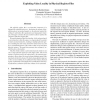Free Online Productivity Tools
i2Speak
i2Symbol
i2OCR
iTex2Img
iWeb2Print
iWeb2Shot
i2Type
iPdf2Split
iPdf2Merge
i2Bopomofo
i2Arabic
i2Style
i2Image
i2PDF
iLatex2Rtf
Sci2ools
MICRO
2003
IEEE
2003
IEEE
Exploiting Value Locality in Physical Register Files
The physical register file is an important component of a dynamically-scheduled processor. Increasing the amount of parallelism places increasing demands on the physical register file, calling for alternative file organization and management strategies. This paper considers the use of value locality to optimize the operation of physical register files. We present empirical data showing that: (i) the value produced by an instruction is often the same as a value produced by another recently executed instruction, resulting in multiple physical registers containing the same value, and (ii) the values 0 and 1 account for a considerable fraction of the values written to and read from physical registers. The paper then presents three schemes to exploit the above observations. The first scheme extends a previously-proposed scheme to use only a single physical register for each unique value. The second
Related Content
| Added | 05 Jul 2010 |
| Updated | 05 Jul 2010 |
| Type | Conference |
| Year | 2003 |
| Where | MICRO |
| Authors | Saisanthosh Balakrishnan, Gurindar S. Sohi |
Comments (0)

